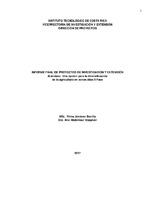Arándano: Una opción para la diversificación de la agricultura en zonas altas II Fase
Abstract
Vaccinium consanguinium es un arándano nativo de Costa Rica que presenta cualidades nutricionales y antioxidantes que lo hace un fruto de alto valor medicinal y nutricional. Su adaptación a las zonas altas del país lo posiciona como especie de interés, por lo que, disponer de técnicas para la obtención de material de siembra clonal es recomendable. El objetivo de esta investigación fue continuar con el desarrollo del protocolo para la micropropagación de esta especie. Se validó la etapa de establecimiento in vitro y se incluyó el uso de desinfectantes más efectivos como la combinación de jabón enzimático (5 ml.l -1 ) y hipoclorito de sodio (3% i.a.) en esta etapa. Se logró establecer material de campo en el invernadero mediante la siembra de plantas, enraizamiento de estacas y germinación de semillas sin necesidad de usar ningún tipo de reguladores de crecimiento y se observó 100% de supervivencia y adaptación a las condiciones ambientales del invernadero. Una señal de la adaptación mostrada por las plantas recolectadas en el campo fue que el 40% presentó floración y fructificación. Con las estacas establecidas asépticamente se evaluó el efecto de tres reguladores del crecimiento en el medio de cultivo WPM al 50%, BA (0, 3, 5, 10, 15 y 20 mgl-1 ), Z (0, 0,1, 0.5 mgl-1 ), observándose que ambas citocininas fueron efectivas en concentraciones de 3 mgl-1. y 0,1 mgl-1 respectivamente , pero el mejor procedimiento para la brotación y multiplicación consistió en la exposición de las microestacas a un choque térmico a 5ºC por 15 días, utilizando el mismo medio con 120 gl-1 de sacarosa y 0,1 mgl-1 de Z. Posteriormente, los materiales fueron transferidos al medio WPM líquido suplementado con 30 gl-1 de sacarosa y 0,1 mgl-1 de Z con puente de papel de filtro, lo que disminuyó la oxidación de los explantes y mejoró las condiciones nutricionales del cultivo reflejándose en mayor crecimiento y mejor apariencia de los brotes. Vaccinium consanguinium, blueberry native to Costa Rica, presents nutritional and antioxidant qualities that makes it a fruit of high medicinal and nutritional value. Its adaptation to the highlands of the country places it as a species of interest, so that having techniques for obtaining clonal planting material are advisable. The objective of this research was to continue the development of the protocol for the micropropagation of this species. The in vitro establishment stage was validated and the use of more effective disinfectants such as the combination of enzymatic soap (5 ml.l-1) and sodium hypochlorite (3% i.a.) was included at this stage.
It was possible to establish field material in the greenhouse by sowing plants, rooting cuttings and seed germination without using any type of growth regulators, 100% survival and adaptation to environmental conditions of the greenhouse were observed. A sign of the adaptation shown by the plants harvested in the field was that 40% presented flowering and fruiting. With the aseptically established stakes, the effect of three growth regulators in 50% WPM culture medium, BA (0, 3, 5, 10, 15 and 20 mgl-1)and Z (0, 0.5 mgl-1), both cytokinin being effective at concentrations of 3 mgl-1 and 0.1 mgl-1 respectively, but the best procedure for sprouting and multiplication consisted in exposing the micro-cuttings to a heat shock at 5º C for 15 days, using the same medium with 120 gl-1 of sucrose and 0.1 mgl-1 of Z. Subsequently, the materials were transferred to the liquid WPM medium supplemented with 30 gl-1 sucrose and 0.1 mgl-1 of Z with a filter paper bridge, which reduced the oxidation of the explants and improved the nutritional conditions of the culture, being reflected in higher growth and better appearance of the outbreaks.
Description
Proyecto de Investigación. Instituto Tecnológico de Costa Rica. Vicerrectoría de Investigación y Extensión (VIE). Escuela de Biología, 2017


